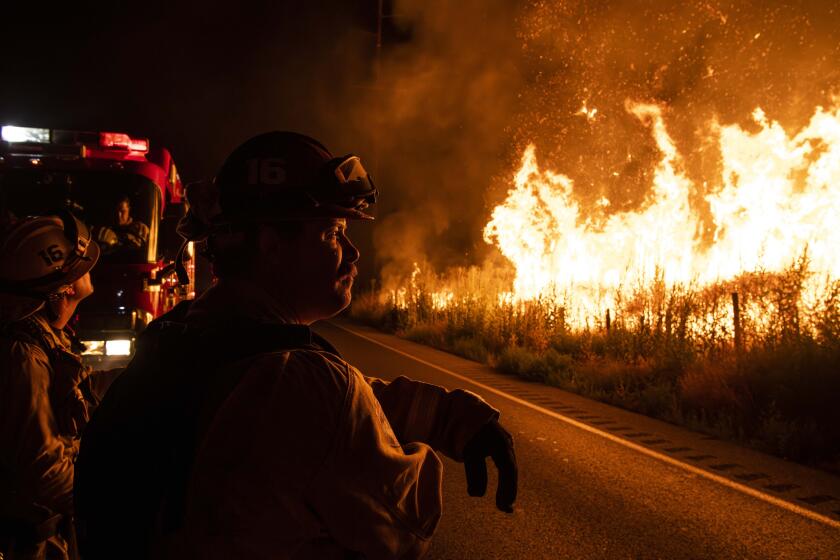Clues Suggest Arsonists Set at Least 6 Fires
- Share via
It will be weeks, perhaps months, before investigators pinpoint the cause of some of the fires still raging through Southern California. But wet piles of debris from one conflagration after another have yielded clues suggesting that at least six blazes were the work of arsonists.
By nightfall Thursday, authorities said they believed arsonists were to blame for four fires in Ventura County, one in Villa Park and the region’s most disastrous, the blaze that engulfed Laguna Beach. Although no suspects have been identified, investigators do have a few tantalizing clues--golfers at the Los Robles Golf Course and Country Club spotted a suspicious person loitering near the origin of the Thousand Oaks fire in Ventura County, and a black Pontiac was seen speeding from the area where the Villa Park fire erupted, authorities said.
The situation is bleaker in Laguna Beach, site of what is expected to be the costliest of the devastating rash of Southern California fires. Officials there say the blaze was deliberately set, and they believe it was the work of someone bent on destruction, not on children playing with matches. But they have no clues as to who was responsible.
“You talk about frustrating,” said Capt. Dan Young, a spokesman for the Orange County Fire Department. “They just destroyed the community.”
As they surveyed the damage in Laguna Beach and throughout Southern California, arson experts said it was criminals, just as much as high winds and dry brush, that spread this week’s fires with such terrifying speed. Arsonists often are stimulated by the clamor surrounding fires, and experts say the police radio traffic and news reports of the Thousand Oaks blaze may have encouraged arsonists to leap into the act.
“A lot of these arsonists have scanners. They’re listening to the calls, and that excites them,” said Doug Allen, president of the California Conference of Arson Investigators. “That’s all part of the thrill.”
Of the fires that have so far been blamed on people, only one suspect was in custody Thursday. Andres Z. Huang, 35, was arrested on suspicion of recklessly setting a fire, not the more serious charge of arson. Huang, who was arrested at 6:45 a.m. Wednesday, is expected to be arraigned today.
According to authorities, Huang had taken refuge from gusting winds Tuesday night in a small gully in the foothills above Altadena. He awoke shortly before dawn, shivering and cold. Authorities said that Huang, a native of China who came to the United States from South America about two months ago, lit the fire to keep warm, but it got away from him, igniting the thick brush in the canyon.
Frightened, Huang allegedly got up to run, but he tumbled down a hillside, hurting himself in the fall.
“It was an illegal fire, but not arson,” said Los Angeles County fire spokesman Clark Pearson. “He was not out to do this.”
Nevertheless, Huang’s campfire tore through the dry canyon country and destroyed more than 100 homes. Thursday, fire crews picked through the charred hillsides near the origin of the Altadena fire, turning over stumps, grubbing out burning roots and running down hot spots.
Fire officials said they discovered a ring of stones in one canyon gully, evidence that Huang had built a campfire and had not attempted to commit arson.
While Huang was recovering at the County-USC Medical Center jail ward, the search for arsonists responsible for other fires was just beginning. Local authorities are handling those investigations, but the federal Bureau of Alcohol, Tobacco and Firearms has offered its assistance and is prepared to lend a hand if needed, a bureau spokesman said.
It will probably be several days before local authorities determine exactly how much help they need.
Although every fire is different, determining how a fire begins and who is responsible is a methodical process that follows time-tested patterns.
The investigations begin as soon as a blaze is sufficiently under control. Thursday, with fires still raging throughout Southern California, many investigators had not even been able to launch their inquiries.
The first task, experienced investigators say, is to locate the origin of the blaze. That alone can take days.
Investigators start by examining the smoke and burn patterns of a fire. Soot stains on rocks and burn marks on trees or telephone poles still standing can indicate the direction a fire traveled.
“It’s a mix of luck and investigation,” said Detective Richard Edwards of the Los Angeles County sheriff’s arson and explosive detail. “You look at fire patterns, stumps, telephone poles and even the ground. You try to determine the direction from which the flames came.”
The very nature of the event makes coming by clues as to how a blaze began extremely difficult. Fire destroys much of the evidence, and what’s left is often ruined by fire crews, whose priority is putting out the blaze, not preserving the crime scene.
Still, sometimes the answers are obvious. A San Bernardino County fire that erupted Wednesday morning has been blamed on power lines, whereas a San Diego County blaze was attributed to children playing with matches.
That’s what investigators hope for. But more often, their inquiries are laborious. Before determining that an arsonist is responsible, investigators have to rule out every other possible cause--from lightning to spontaneous combustion.
“It’s probably the hardest crime to solve,” said Allen, who investigated fires for 30 years as a California Department of Forestry official. “It is like putting together a mosiac puzzle without all the pieces.”
Sometimes authorities do get lucky. When fire investigators picked through the rubble of one 1987 Bakersfield blaze, they found the remains of an incendiary device, a cigarette butt and matches wrapped in yellow legal paper. What’s more, the paper had a smudged fingerprint.
Government experts concluded that the print belonged to John Orr, a nationally acclaimed arson investigator with the Glendale Fire Department. Then they discovered that Orr had written a 418-page manuscript, titled “Points of Origin,” about a serial arsonist.
Prosecutors eventually succeeded in winning the right to introduce as evidence in Orr’s trial the manuscript and letters he had written to literary agents. Although he proclaimed his innocence, Orr was convicted in one case and later pleaded guilty in a second. He is serving a federal prison sentence.
Prosecutors considered the Orr manuscript important evidence in their case against him, but experts say it is surprisingly common for arsonists to keep a record of their crimes. Many arsonists keep diaries or logs, they say, and those documents can provide damning evidence at trial.
Although experts caution that it is difficult to draw a profile of a typical arsonist, some say they do share traits. Many are loners who work by themselves, planning their crimes in great detail. They often admire authority figures, sometimes going so far as to buy police or fire uniforms. They show little if any compassion for the property or people they destroy with their crimes. They like to watch the fires they set. And, if not caught, they tend to strike again and again.
Those traits, however, can be misleading.
“There are so many stereotypes,” said Lawrence Sporty, a senior lecturer in psychiatry at UC Irvine. “But the truth is, they come from all walks of life. You see fires started by everyone from people who work in fire departments to people who suffer from mental illness.”
Ultimately, identifying and arresting an arson suspect requires a combination of legwork and luck. After investigators have nailed down a fire’s origin and scoured the area for physical evidence, their best bet usually is to pound the pavement, sometimes for weeks on end, to find eyewitnesses.
It is a grueling and often fruitless undertaking. For all the work that investigators put into arson cases, it remains one of the least solved--and most costly--of all crimes.
According to FBI statistics, authorities arrested just 17.3% of all arson suspects last year. By contrast, more than half of all rape suspects were apprehended, as were 65% of all suspected murderers.
Moreover, with billions in property losses and thousands of lives snuffed out or disrupted every year, arson remains one of the most wrenching and expensive of all crimes. Thursday, as Orange County officials and Gov. Pete Wilson toured the site of the Laguna Beach blaze, they gazed out on the destruction in anger.
“The person who would do something like this is sick and, frankly, pathetic,” said county Supervisor Gaddi H. Vasquez. “Obviously in this type of climate, the danger was enormous.”
More to Read
Sign up for Essential California
The most important California stories and recommendations in your inbox every morning.
You may occasionally receive promotional content from the Los Angeles Times.











